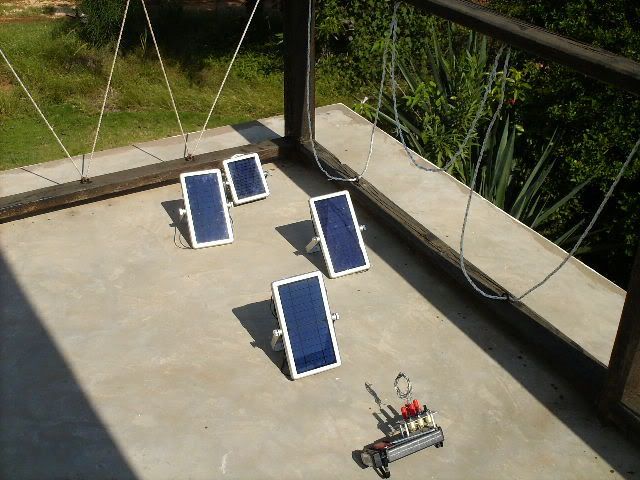From void into vision, from vision to mind, from mind into speech, from speech to the tribe, from the tribe into din.
Showing posts with label Jamaica. Show all posts
Showing posts with label Jamaica. Show all posts
Monday, August 06, 2007
Dancing the Cube in Jamaica
This is a video Julie of Videosphere took December 2006 of Azisu, Nikita, Chaka, Werner, and Bud playing with a magnetic Quanta Cube, a cube made of 72 A and B Quanta. The A and B Quanta are the smallest common symmetrical tetrahedra of the regular tetrahedron and octahedron, two of the Platonic Solids. They were first discovered and analyzed by R Buckminster Fuller and Dr Arthur Loeb. Both the A and B Quanta come in left-hand and right-hand pairs, they are mirror images of each other, enantiomorphs. As positive/negative pairs, they are perfect for magnetic coupling and there are magnets at the centers of each of the four faces of each Quanta in the Quanta Cube, 288 magnets in all.
The Quanta Cube is derived from the work of M. Preston Burns, Bud, the skinny old dude in the video, who built his first Pandora's Box nearly 40 years ago. We worked together building various models of the box at different scales from eight feet to six inches and demonstrated them before the public and as part of an arts curriculum with Tribal Rhythms. Bud dissected a cube along its diagonals, hinged the pieces, and packed a "winged tetrahedron," a hinged tetrahedron with eight equilateral triangles, in the center. He filled the corners of the cube with ToxBlox, illustrating the symmetrical divisions of the cube. That is Pandora's Box.
One day, I was playing with a set of A and B Quanta I had made and discovered how to fill the box with A and B Quanta. Later I developed the magnetic coupling system with Carl Fasano of RISD.
More on Synergetic geometry and R. Buckminster Fuller at
http://www.rwgrayprojects.com/synergetics/synergetics.html
http://synergeticists.org
http://www.bfi.org/
More video of the Quanta Cube at
http://energyvision.blogspot.com/2006/02/evolution-of-cube.html
More geometry video from RISD:
http://energyvision.blogspot.com/2006/02/geometry-study.html
Wednesday, December 27, 2006
Cell Phone Solar: What I Learned in Jamaica

Driving up to Junction on twenty miles of bad road, we stopped for directions at a gas station and picked up an older woman waiting for a ride who guided us the rest of the way. A mile or two later, we turned a corner and saw a line of wind turbines on the slopes of Don Figeroa Mountain, the Wigton wind project (http://www.mct.gov.jm/energy_5.htm). I turned in my seat and asked the woman on her way to Junction whether the wind machines had made any difference.
She said, "No, mon, we still have to pay for the electric and the gas."
A little farther down the road we passed a sign for DigiCel, the local cell phone company. I turned to her again and said, "But the cell phone changed everything, didn't it?"
She smiled widely and nodded deeply.
On the sun porch and veranda, we videotaped the solar electric light system we'd brought. We showed the three different sizes of interconnecting solar panels and LED lamps with batteries in their cases and displayed the different sets of connectors. We had one connector to go from the battery to a USB device, another was a 12 volt socket like a car lighter. We had a set of attachments to charge cell phones from the solar batteries and another that let us connect directly to the solar panels as well.
In fact, we also had a solar/dynamo flashlight/radio which we were using to charge the rechargeable AAs the digital cameras required and a hand cranked dynamo specifically designed for charging cell phones. From what we saw, people in Jamaica were using mostly AAs and D cell batteries but we didn't have a D cell battery bay, only the one for AAs, a set of alligator clips,, and the multimeter.
We had cell phone solar.
Cell phone solar and AA/D cell charging: that's emergency, camping, and most of the world and it's a scale that is understandable, accessible, and probably affordable.
One night, I was talking to some Jamaican kids at Doreen's bar, the local watering hole a few steps away from the guest house. We showed them the lights and explained how the batteries in the lamps could also charge cell phones. They liked that idea a lot. I told them that the large solar lights cost $75 American and the smallest, the one on my backpack, was $30 American. They didn't like that. I said I thought solar lights and cell phone chargers could probably be available for $5 to $10 American and their eyes lit up.
Here's what I learned in Jamaica:
Cell phones change everything.
Cell phone solar with AA/D battery charging is a useful minimum scale.
The price point should be around $10 American or less.
Subscribe to:
Comments (Atom)